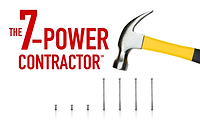Minimizing jobsite accidents
The power of CYA.

Don’t underestimate the power of a good CYA program.
OK, I don’t know what you think I meant when I wrote CYA; I meant “cover your anatomy!” I bet you thought my being from New York that the A in CYA meant something else besides anatomy.
Am I right?
I hope I got you to chuckle but this is a very serious topic.
The nature of our business may require us to play with fire, water, air, hang from rooftops and a whole lot more that can put customers’ lives and property at risk. It also can put our staff at risk. There is enormous potential for liability lurking around every corner. I’m afraid that comes with the territory of being a contractor.
So, what can we do about it?
We can be better prepared and train like crazy.
The key is to have safety best practices and OSHA code compliance in place at your company. That means they are in writing and well-known by all who need to follow them.
The best way to approach CYA is in prevention, which means beforesomething goes wrong. But the reality is sometimes CYA can come into play aftersomething happens. Then, the customer can perceive you caused something to happen. We’re living in a litigious society today. That means it is more a matter of when, and not if, this will come into play.
For example, I was working at a customer’s home; the water heater needed to be drained and flushed, which I did. Two days later, the client called in to complain that his third-floor sink was dripping and whatever I did had caused it. This is why I teach technicians to get permission to look around the home with the customer, because whatever goes wrong for the next two weeks, the tech will be blamed for having caused it … at least in customers’ minds.
The good news is that if you are proactive, you can reduce the likelihood of an incident happening in the first place. This requires you to have a detailed approach to how you do your work in order to minimize safety issues and unnecessary insurance claims. You need to have a safety program that reduces mistakes and establishes best practices at your company if you want to minimize the need for a CYA. Or, at worst when something does go wrong, you have at least kept it to something small and harmless vs. big and dangerous.
Avoid frightening scenarios
The trick is whatever you create in writing must be known by all who need to know it. These safety methods must be practiced at your shop, then done in the field and inspected to verify they are being followed on a regular basis.
I had a troubling call from a contractor who I wasn’t working with but who had read my articles. He had an employee who entered a home where a carbon monoxide alarm had sounded. The technician performed a service call without any company-written policies and procedures in place. The tech left the job. And the call he ran didn’t result in a safe and practical way to resolve the issue.
The customer suffered carbon monoxide exposure. Fortunately, he caught on quickly before an even greater health and safety issue arose. He sought medical attention and was properly diagnosed. Still, the contractor who called me was now in a world of hurt.
Yikes, what a frightening scenario!
How can you minimize a similar incident?
A great place to start is by working with your local emergency responders about how to approach these types of calls. It benefits everyone. Your own insurance provider has many types of services it can provide to help keep everyone safe — clients and employees. Professional trade associations can be a helpful resource, too.
Whatever way you arrive at a solid policy and procedure for these types of calls or similar scenarios in the trade(s) you do, it’s only part of the solution.
Your company must have ongoing training on how to perform safety best practices regularly so it becomes known and done in the field the correct way. If you want to move your training to the next level, reduce callbacks and provide the best chance to CYA, you’ll want to invest in a real-world training center that can simulate calls on the type of trade you’re in. Remember, safety first if and when you engage in this.
Involve your team in approaching how to do your work — whether its plumbing, heating or cooling — from every angle that provides safety first. This will help you arrive at a best practice that allows you to run calls the right way and reduce risk for all because the risk is great enough to put you out of business and ruin you financially.
Should you find yourself battling with insurance companies or the courts in this type of case, you’ll be better off for having a written policy that’s been reviewed regularly by professionals.
It’s just smart business to protect the health of both our customers and our employees. And more importantly, it’s the right thing to do.
Customers can sometimes be their own worst enemy when they ask us to do something we know can be potentially unsafe, such as bypassing a limit that exists for their safety. It’s easy to want to please a customer but it’s a dangerous path to take when you know it’s unsafe to do so. Techs have to be empowered on how to proceed in these types of situations. It still boils down to safety first, but how you exit the call is very important. You can be dragged back into this situation if you don’t document everything the proper way.
As Benjamin Franklin said, “An ounce of prevention is worth a pound of cure.”
Looking for a reprint of this article?
From high-res PDFs to custom plaques, order your copy today!






